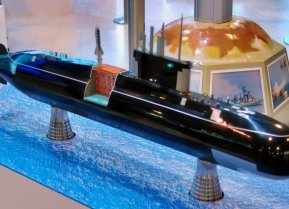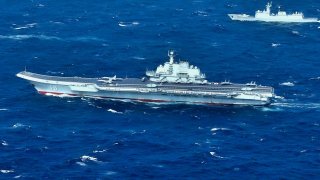China Is Flexing Its Aircraft Carrier Muscles Near Taiwan
The People's Liberation Army Navy (PLAN) aircraft carrier Type 002 Shandong transited the Taiwan Strait on Monday and, according to Taiwanese officials, had remained on the Chinese side of the median line – the unofficial nautical barrier between the mainland and the self-ruling island.
The People's Liberation Army Navy (PLAN) aircraft carrier Type 002 Shandong transited the Taiwan Strait on Monday and, according to Taiwanese officials, had remained on the Chinese side of the median line – the unofficial nautical barrier between the mainland and the self-ruling island.
The Type 002 Shandong is the first domestically built Chinese aircraft carrier, commissioned in 2019. It was only this past April that the PLAN flattop conducted its first drills in the Pacific Ocean. The carrier has returned to those waters, however, in September and October of this year – while it had most recently transited the strait last month.
Beijing has applied pressure in the region ahead of Taiwan's elections next month.
China's Incredible Expanding Aircraft Carrier Fleet
China's PLAN, or Navy, currently operates two aircraft carriers, one of which – the Liaoning – was the former Soviet-era Kuznetsov-class carrier Varyag that was purchased from Ukraine and refurbished for service with the Chinese military; while the other has become Beijing's first domestically-built carrier.
However, Shandong is still based on the Soviet Kuznetsov-class design and features a ski jump-style deck. Both the Type 001 and Type 002 have a limited endurance of just six days at sea before requiring refueling.
The Type 003 Aircraft Carrier – Almost Ready for Service
China's newest aircraft carrier, the Type 003 Fujian, was officially launched in June of last year and could be ready to take to the seas after it completes its current testing phase. Photos on social media showed that the sheds and decks placed around the Fujian for testing have been removed.
Sea trials could take several weeks to complete, but final training for the crew is expected to take about two years before the Fujian will be ready for its maiden deployment.
The warship is the largest flattop to be built in China, and it is China's most advanced warship. When the Type 003 Fujian enters service, China will have the second-largest number of operational aircraft carriers of any navy in the world.
Though the Type 003 Fujian is conventionally powered, it will be equipped with electromagnetic catapult devices, which are more effective than the steam catapult devices used on other carriers. To date, electromagnetic catapults have only been used on the U.S. Navy's Gerald R. Ford-class carriers. The added power of the electromagnetic catapults allows for heavier aircraft and shorter runways.
The Fujian is reported to carry as many as 40 jet fighters. Beijing's current carriers can handle 18 and 32 fighters. It is currently at the Jiangnan Shipyard and is believed to be preparing for its maiden sea trials, a critical step towards its active service.
J-35 Mockup Seen on the Type 003's Flight Deck
Earlier this month, images also circulated online that showed a suspected mock-up of a J-35, a carrier-based variant of the Shenyang FC-31 Gyrfalcon (also known as the J-31), on the Type 003 Fujian's flight deck. The latest images were first shared on China's X-like social media microblogging site Weibo on December 8.
There has been speculation that the FC-31 variant might be designed to utilize a ski-jump flight deck, which would enable it to operate from the Type 001 Liaoning or the Type 002 Shandong. Still, the presence of such an aircraft – even as a mock-up – on the Type 003 suggests it could be launched via catapult.
It is unlikely a single aircraft design could effectively operate from both types of carriers.
Aircraft Carrier Launch Tests Underway
Last month, the Fujian had begun tests of its electromagnetic catapult launch system. The PLAN is just the second navy after the United States Navy to adopt the technology.
The USS Gerald R. Ford (CVN-78) became the first carrier to employ an electromagnetic aircraft launch system (EMALS). It enables faster take-offs, increases energy efficiency, and puts less stress on the airframes during launches.
An electromagnetic catapult can also deploy a wider range of aircraft, including manned and unmanned systems. That can include transport aircraft, fixed-wing early-warning and control aircraft, and large drones.
The test vehicle didn't actually take to the skies – as it is a "dead load," and instead it fell into the water basin forward of the ship.
Such tests are common for all catapult-equipped aircraft carriers, both during initial construction and then after major overhauls. According to Naval News, such a test was conducted following the French Navy's flagship carrier Charles de Gaulle in Toulon.
What We Know About the J-35
It has also been reported that the FC-31 has a stealth aerodynamic design and likely has stealth coating – but there are other factors to consider including radar-absorbent coating materials and the use of internal weapons bays.

According to images circulated on Chinese social media, the J-35 fighter was also seen undergoing tests in August—a now vital source of information for military analysts who would otherwise struggle to gain access to sensitive developments in China's defense planning, Newsweek reported. The aircraft and aircraft carrier are both fundamental to Beijing's plans to have a world-class navy.
Author Experience and Expertise
Peter Suciu is a Michigan-based writer. He has contributed to more than four dozen magazines, newspapers, and websites with over 3,200 published pieces over a twenty-year career in journalism. He regularly writes about military hardware, firearms history, cybersecurity, politics, and international affairs. Peter is also a Contributing Writer for Forbes and Clearance Jobs. You can follow him on Twitter: @PeterSuciu.
Image Credit: Creative Commons.


